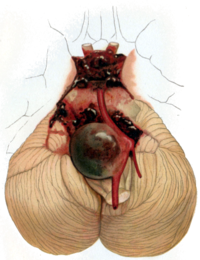
Photo from wikipedia
BACKGROUND Radiomics is a powerful tool for automatic extraction of morphologic features, but when applied to cerebral aneurysms is inferior to established descriptors in classifying rupture status. We sought a… Click to show full abstract
BACKGROUND Radiomics is a powerful tool for automatic extraction of morphologic features, but when applied to cerebral aneurysms is inferior to established descriptors in classifying rupture status. We sought a strategy to recover neck orientation and parent vessel caliber in a bid to enhance Radiomics performance and facilitate its adoption for aneurysm risk stratification. METHODS 135 sidewall (32 ruptured) and 216 bifurcation (90 ruptured) aneurysms from 3-dimensional rotational catheter angiography (3DRA) datasets were analyzed. Clinical 3DRA defined in arbitrary orientation underwent affine transformations enabling aneurysm neck alignment to XY plane prior to analysis in PyRadiomics, thus facilitating automatic extraction of aneurysm height and width, previously not possible with random alignment. Additionally, parent vessel size was estimated from aneurysm location, and incorporated into enhanced Radiomics (height, width, height/width, size ratio). Rupture status classification was compared across methodologies, for 31 automatically computed conventional Radiomics, enhanced Radiomics, and established size/shape descriptors using univariate, multivariate, and area under the curve (AUC) statistics. RESULTS Enhanced Radiomics derived Height/Width and Size Ratio were significantly higher in both ruptured subsets. Using multivariate analysis in sidewall lesions, enhanced Radiomics (AUC=0.85) matched established features (AUC=0.86) and outperformed conventional Radiomics (AUC=0.82); in bifurcation lesions enhanced Radiomics (AUC=0.78) outperformed both established features (AUC = 0.76) and conventional Radiomics (AUC=0.74). CONCLUSION Enhanced Radiomics incorporating neck orientation and parent vessel estimate is an efficient operator-independent methodology which offers superior rupture status classification for both sidewall and bifurcation aneurysms and should be considered a strong candidate for larger scale multi-center and multi-modality validation.
Journal Title: World neurosurgery
Year Published: 2021
Link to full text (if available)
Share on Social Media: Sign Up to like & get
recommendations!